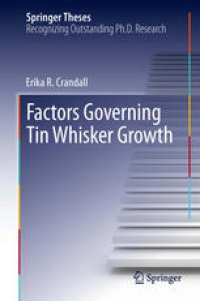
Ebook: Factors Governing Tin Whisker Growth
Author: Erika R Crandall (auth.)
- Tags: Electronic Circuits and Devices, Circuits and Systems, Metallic Materials, Surfaces and Interfaces Thin Films, Surface and Interface Science Thin Films
- Series: Springer Theses
- Year: 2013
- Publisher: Springer International Publishing
- Edition: 1
- Language: English
- pdf
Tin (Sn) whiskers are electrically conductive, single crystal eruptions that grow from Sn film surfaces. Their high aspect ratio presents reliability problems for the electronics industry due to bridging and metal arcing, leading to malfunctions and catastrophic failures in many electronic systems (including satellite and defense sectors). Due to legislation in the EU, Japan, and the U.S., mandating a gradual shift from lead (Pb)-based to lead-free solders and board finishes, there has been a reemergence of Sn whiskers. Continuing reports of Sn whisker induced failures coupled with the lack of an industry-accepted understanding of whisker growth and/or test methods to identify whisker prone products has made pure/high Sn substitutes a risky proposition in high reliability systems.
This thesis is designed to clarify and control the fundamental mechanisms that govern whisker formation. The research focuses on reproducible "laboratory" created whiskers under a variety of rigorously controlled environmental factors such as film thickness, film stress, substrate material, gas environment, and humidity exposure, which are known to play a significant role in whisker production. The ultimate question of how to impede and/or prevent whisker growth is also addressed and shows that whisker prevention is possible via hard metal capping films, which are impenetrable by whiskers.
Tin (Sn) whiskers are electrically conductive, single crystal eruptions that grow from Sn film surfaces. Their high aspect ratio presents reliability problems for the electronics industry due to bridging and metal arcing, leading to malfunctions and catastrophic failures in many electronic systems (including satellite and defense sectors). Due to legislation in the EU, Japan, and the U.S., mandating a gradual shift from lead (Pb)-based to lead-free solders and board finishes, there has been a reemergence of Sn whiskers. Continuing reports of Sn whisker induced failures coupled with the lack of an industry-accepted understanding of whisker growth and/or test methods to identify whisker prone products has made pure/high Sn substitutes a risky proposition in high reliability systems.
This thesis is designed to clarify and control the fundamental mechanisms that govern whisker formation. The research focuses on reproducible "laboratory" created whiskers under a variety of rigorously controlled environmental factors such as film thickness, film stress, substrate material, gas environment, and humidity exposure, which are known to play a significant role in whisker production. The ultimate question of how to impede and/or prevent whisker growth is also addressed and shows that whisker prevention is possible via hard metal capping films, which are impenetrable by whiskers.
Tin (Sn) whiskers are electrically conductive, single crystal eruptions that grow from Sn film surfaces. Their high aspect ratio presents reliability problems for the electronics industry due to bridging and metal arcing, leading to malfunctions and catastrophic failures in many electronic systems (including satellite and defense sectors). Due to legislation in the EU, Japan, and the U.S., mandating a gradual shift from lead (Pb)-based to lead-free solders and board finishes, there has been a reemergence of Sn whiskers. Continuing reports of Sn whisker induced failures coupled with the lack of an industry-accepted understanding of whisker growth and/or test methods to identify whisker prone products has made pure/high Sn substitutes a risky proposition in high reliability systems.
This thesis is designed to clarify and control the fundamental mechanisms that govern whisker formation. The research focuses on reproducible "laboratory" created whiskers under a variety of rigorously controlled environmental factors such as film thickness, film stress, substrate material, gas environment, and humidity exposure, which are known to play a significant role in whisker production. The ultimate question of how to impede and/or prevent whisker growth is also addressed and shows that whisker prevention is possible via hard metal capping films, which are impenetrable by whiskers.
Content:
Front Matter....Pages i-xii
Introduction: Whiskers and Their Role in Component Reliability....Pages 1-24
Film/Substrate Effects on Whisker Growth....Pages 25-66
Environmental Effects on Whisker Growth....Pages 67-105
Whisker Mitigation and Prevention....Pages 107-123
Conclusions....Pages 125-131
Back Matter....Pages 133-136